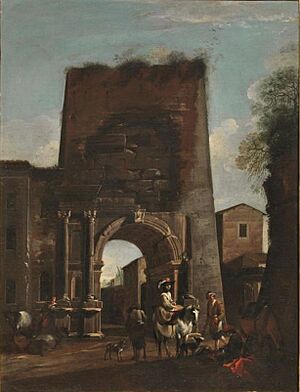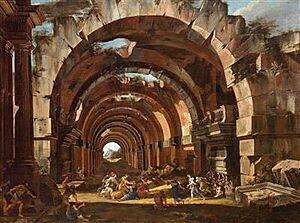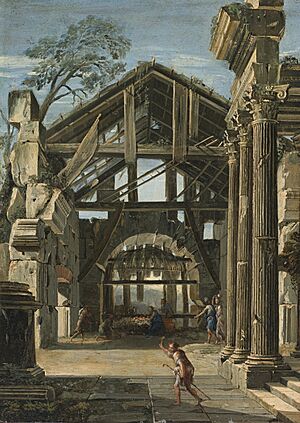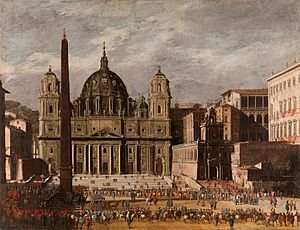Viviano Codazzi facts for kids
Viviano Codazzi (born around 1604 – died November 5, 1670) was an Italian artist. He was a special kind of painter who focused on buildings and Baroque art. He was famous for his paintings of buildings, imaginary scenes called capricci, and pictures of ruins. He also painted some real-life views, known as vedute. Viviano Codazzi worked in the cities of Naples and Rome. Sometimes, older books call him Viviano Codagora or il Codagora.
Contents
Who Was Viviano Codazzi?
Viviano Codazzi was born near Bergamo in a place called Valsassina around the year 1604. His family moved to Rome by 1605.
Early Life and Training

Viviano probably learned to paint in Rome. By 1633, he moved to Naples. There, he got jobs painting for the Certosa di San Martino. He made these connections through Cosimo Fanzago, who was also from Bergamo.
One big job in Naples was painting four large pictures for the Buen Retiro in Madrid. These paintings showed old Roman scenes, like gladiators fighting in the Colosseum. Another artist, Domenico Gargiulo, painted the people in these pictures. Codazzi was a master of buildings, so other artists always added the figures. Gargiulo was his main partner for this in Naples.
Viviano married Candida Miranda from Naples on May 3, 1636. They had seven children. Two of their sons, Niccolò and Antonio, also became painters.
Moving to Rome and Collaborations
After a big event called the revolt of Masaniello in 1647, Viviano moved back to Rome. In Rome, he worked with a group of mostly Dutch and Flemish painters. These artists were known as the Bamboccianti.
His most frequent partners were Michelangelo Cerquozzi and Jan Miel. In the 1660s, he also worked with Filippo Lauri, Adriaen van der Cabel, and Vicente Giner. Even famous artist Artemisia Gentileschi asked Viviano Codazzi to paint the building backgrounds in some of her works. An example is her painting Bathsheba at the Columbus Museum of Art.
Viviano's Influence on Other Artists
Many artists followed Viviano Codazzi's style. These included Ascanio Luciano and Andrea di Michele in Naples. His son Niccolò Codazzi (1642–1693) and Vicente Giner from Spain were also his followers.
Artists in Northern Europe like Wilhelm Schubert van Ehrenberg and Jacobus Ferdinandus Saey were also inspired by his art.
Viviano's son, Nicolo (1642-1693), painted buildings and imaginary scenes just like his father. Another son, Antonio, was also a painter, but his work is not as well known.
Even though he was a busy artist, Viviano Codazzi was listed as poor in 1657. He lived in Rome for most of his later life. He died in Rome on November 5, 1670.
What Did Viviano Codazzi Paint?
Most of Codazzi's paintings are medium-sized. They show buildings, often ruins, or perfect imaginary buildings. These scenes are usually set in a landscape. This type of decorative building painting became very popular in Rome in the mid-1600s.
Art experts believe that these architectural paintings became popular because people started buying art more freely. Before, art was mostly made for specific orders. These building paintings fit well into homes where walls were covered with many different types of art. They added interesting straight lines and shapes to the room.
The Roots of Architectural Painting
This style of painting buildings came from art in the 1500s. It was especially seen in the painted backgrounds of large wall and ceiling artworks. These backgrounds were called quadratura. In the 1600s, these painted buildings became important enough to be the main subject of a painting.
Many artists painted in this style. Alessandro Salucci was an important artist of that time who was influenced by Viviano Codazzi. Codazzi's views were usually more realistic than Salucci's. Salucci was more creative and would rearrange Roman monuments in his paintings.
Codazzi did not always stick strictly to real places or history either. His goal was to create beautiful arrangements of buildings that looked harmonious. People in his time praised Codazzi. They said he was like the ancient architect Vitruvius among painters of architectural views. This showed that he was a master of perspective and understood ancient styles.
Famous Works
Codazzi's painting of St. Peters Basilica from 1636 is more of a veduta, meaning a real view, than an imaginary scene. He painted it in Naples. It shows the old entrance to the Vatican palace, which was later changed. It also shows clock towers based on a design that was never actually built.
One of his most famous paintings shows the Revolt of Masaniello in the Piazza del Mercato in Naples. Michelangelo Cerquozzi painted the people in this work. It was made in 1648 for Cardinal Bernardino Spada. Today, you can see it in the Galleria Spada in Rome.
Images for kids
See also
 In Spanish: Viviano Codazzi para niños
In Spanish: Viviano Codazzi para niños





